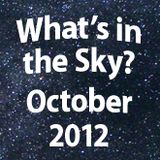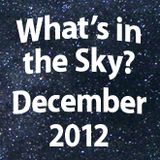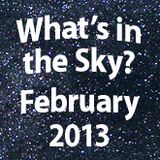
For those of us who live in northern climes, winter astronomy is a mixed blessing. Some of the finest objects in the sky are best placed in winter time, but the cold weather often keeps us from enjoying them. In this article I'll give some tips for winter observing, and then highlight some of the sights that will make it worth braving the cold.
Preparing yourself
Crisp winter days can be enjoyable when the Sun shines brightly and you can walk/ski/snowshoe briskly. It's a different matter standing or sitting very still peering through an eyepiece under a winter night sky. The first thing to do is to dress warmly, in layers, in order to retain your body heat. Because astronomy doesn't involve much physical movement, you should dress as if the temperature was at least 10 degrees colder than predicted. The clothing sold for other winter outdoor activities serves very well. I recently discovered jeans lined with flannel at a work clothing store, which serve well on milder nights; I have a fully insulated one-piece boiler suit for really cold nights. A warm hat is especially important, as we lose much of our body heat through our head: I usually wear a wool watch cap. On really cold nights, a ski mask or balaclava is really welcome. It's also important to keep your feet warm: cold feet will kill your observing interest faster than anything else. Insulated working boots will do the trick, but it also helps if you put down an insulating mat under your observing area.
There are some serious safety concerns in winter observing. Hypothermia can creep up on you very subtly. If you?re observing from a remote location, always use the buddy system, and make sure your buddy has his own car, in case you have trouble starting yours. I prefer observing close to home, where I can step inside every hour or so to warm myself up. Be very careful around the metal parts of your telescope: it's extremely easy to freeze your flesh to any exposed metal parts of the scope. If it happens, warm things gradually and separate with great care. A warm beverage in a thermos can help to keep you comfortable, but avoid caffeine and especially alcohol.
Preparing your telescope
Most telescopes are manufactured in parts of the world warmer than where we live. The only telescope I own which seems really happy in winter is my Russian-made Maksutov-Newtonian, which seems to feel right at home at sub zero temperatures! Telescopes give trouble in two specific areas: lubrication and batteries. The lubricants used in telescope mounts, focusers, etc. turn into glue at low temperatures. It's best to strip off the supplied lubricant and replace it with the lithium-based greases designed for snowmobiles.
Batteries depend on chemical reactions to generate current, and chemical reactions go more slowly at lower temperatures. Generally, the smaller the size of the battery, the sooner it will fail at cold temperatures. I often store my telescopes in an unheated garage or shed, but I always store the batteries inside my heated house. The little AA and 9v cells used in most astro equipment are next to useless below freezing. If you?re close to home, use an AC adapter to power your equipment. If you?re in the field, look into the "power tanks" sold by many astronomical suppliers. But before spending a lot of money on one of these, check your local auto supply store for less expensive alternatives. Once again, the larger the physical size of the battery, the longer it will last, and be sure to store it indoors on a trickle charger. It may be tempting to run your equipment off your car?s battery, but you don't want to find yourself with a dead battery when you want to head home.
It's best to store your telescope in an unheated garage or shed, rather than subjecting your scope to drastic temperature changes, plus the heavy condensation which can occur when you bring the scope indoors. If you must bring a very cold scope indoors, cap it tightly while still outside to minimize internal condensation. The same applies to eyepieces and other accessories.
The Rewards!
Is it worth going to all this trouble, rather than staying indoors and viewing Hubble images on the internet? Definitely! Some of the sky's finest sights are overhead in wintertime.
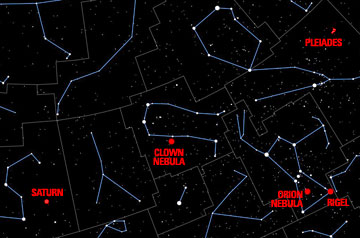 The Orion Nebula (Messier 42 and 43)
The Orion Nebula (Messier 42 and 43)
This is without argument the finest emission nebula in the sky. It is easily found as the middle "star" of the Sword of Orion, hanging below his famous Belt. This is a fantastic site in even the smallest telescope, and only gets better the larger your telescope's aperture and the darker your sky. Try it with every eyepiece you own, with and without a nebula filter. Every view is different, and every one rewarding. I can easily spend an hour or two exploring this wonderful object on any clear night. Try to trace the outermost tendrils of its two widespread arms. Then put on your highest magnification and see how many stars you can see in The Trapezium, the glorious multiple star at its core.

The four brightest stars are pretty easy, but can you spot the elusive fifth and sixth stars? These require good optics and a dark sky, as they are buried in the glow of the surrounding gasses.
Rigel
This is one of my very favorite double stars. I discovered it quite by accident one night when I was testing a new telescope. I was looking for a bright star to use for a star test, and chose Rigel. When I cranked up the magnification, I was amazed to discover than Rigel was not alone, but had a tiny white speck of a companion. Though actually a white dwarf, this star gives the impression of a tiny planet circling a brilliant star. This discovery started me on a quest to observe double stars, for which I used the wonderful list of a hundred doubles recommended by the Astronomical League:
http://www.astroleague.org/al/obsclubs/dblstar/dblstar1.html
Double star observing used to be a mainstay of amateur astronomy, but got shoved aside by deep sky observing for many years. Recently it seems to be enjoying a comeback with several new books published on the subject.
Eskimo or Clown Nebula (NGC 2392)
Summer may have its Ring Nebula and Dumbbell Nebula, but winter's Eskimo Nebula will challenge both of these as the finest planetary nebula in the sky. Located close to the fine double star Wasat (Delta Geminorum), it is easily mistaken for a star at low power because of its small size and brightness.
The Pleiades (Messier 45)
The brightest and one of the closest open star clusters in our neighborhood, The Pleiades makes a fine sight on a crisp winter night. How many stars can you see with your naked eye? Most people can see six, but more can be detected with careful observation. Because of its large size, this cluster is best viewed with binoculars. Under really dark skies, see if you can detect the faint nebulosity which envelopes this cluster. Don't be fooled by haze in our own atmosphere. A good test is to compare the view with the nearby Hyades, which have absolutely no nebulosity associated with them.
Saturn
I saved the best for last! Saturn is now rising in the mid-evening, and is a treat for all astronomers. This planet can tolerate as much magnification as your telescope is capable of, so don't hold back. Look for the shadow of the rings on the planet and vice versa. See if you can detect the hairline Cassini division between the two main rings; how far around the ring can you follow it? Try to spot the faint inner Crepe Ring, most easily seen against the background of the planet, but sometimes visible against the sky. Can you see any belts on the globe, or its greenish polar region? Scan the area around Saturn for its moons. Use Starry NightŪ to print a map of their locations. Titan is easily seen in any telescope. Rhea is more of a challenge and Tethys and Dione require a good eye and telescope. Iapetus follows an odd orbit, and changes in brightness as it moves from west to east. Enceladus is extremely challenging, and tiny Mimas just about impossible.
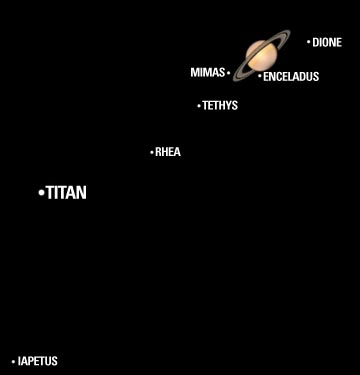
So remember: Dress warmly, be prepared, and enjoy the wonderful sights of the winter sky!
January 2007
Geoff has been a life-long telescope addict, and is active in many areas of visual observation; he is a moderator of the Yahoo "Talking Telescopes" group.







